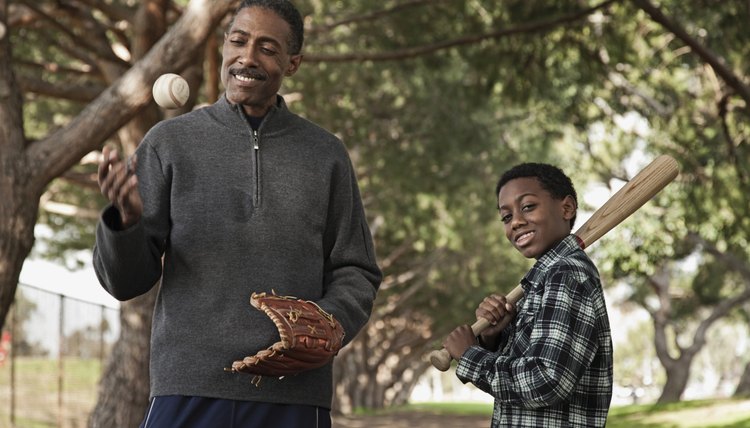The History of Baseball for Kids

Baseball, which calls itself America's pastime, dates back to before the Civil War when it was called rounders. Some people don't care for it due to its slow pace, but it was still popular enough that eight clubs drew more than 3 million visitors in 2013. It has a solid place in American history as the oldest of all of the major sports, and at times its growth has reflected important changes in the country.
First Pitch
Abner Doubleday is often credited with inventing baseball in Cooperstown, New York in 1839. In 1845, Alexander Cartwright -- known as the "father of baseball" -- invented the rules and modern baseball field. His team, the New York Knickerbockers, played in the first ever baseball game against a cricket team in 1846. The Civil War helped spread the game as soldiers from across the land were exposed to baseball. Both sides played it during down times, and some soldiers wrote about games being called on account of gunfire.
Professional Leagues
The game grew fast after the war, with most towns adopting their own sides and playing against nearby towns. That led to the formation of professional leagues, with the National League starting in 1876 and the American League in 1900. The rival leagues played their first combined championship in 1903. They called it the World Series, even though the teams were from Boston and Pittsburgh. The name stuck.
The Black Sox
Baseball in the early part of the century thrived with little competition from other sports and faithful support from newspapers. Baseball players became national heroes. That's why its first scandal made such an impact. Eight players from the Chicago White Sox were accused of throwing the 1919 World Series as part of a gambling scheme. Although the so-called "Black Sox" were acquitted in a courtroom, many fans literally lost faith in the game. It prompted the league owners to bring in a commissioner, a judge named Kenesaw Mountain Landis. Landis banned all of the players involved in the scandal, and the commissioner's position helped break the power of the owners.
Babe Ruth
In 1920, George Herman "Babe" Ruth was sold from the Boston Red Sox to the New York Yankees. The trade that would later be dubbed "The Curse of the Bambino" because the Red Sox didn't win another World Series until 2004. With the Yankees, Ruth won four World Series and became the first player to hit 60 homers in one season. Fans were so in awe of his power that they looked past the Black Sox scandal. Ruth was one of five men elected in the first class of the Baseball Hall of Fame, which opened in 1936 in Cooperstown. The others were Ty Cobb, a nine-time batting champion, Honus Wagner, who retired with more than 3,000 hits, and pitchers Christy Mathewson and Walter Johnson.
Jackie Robinson
Like most American institutions, baseball practiced segregation for the early part of the century. That changed in 1947 when Jackie Robinson, who had previously played in the Negro Leagues, took first base for the Brooklyn Dodgers. He became an immediate symbol since there were few places at the time where people could see an African-American working alongside whites as an equal. His first season was full of protests, from opposing teams, some teammates and some Dodgers fans. Robinson stuck it out, and ultimately won a Most Valuable Player award. As Larry Schwartz wrote for ESPN, Robinson "didn't make a nation color blind, he at least made it more color friendly."
References
- Fact Monster: Baseball in America: A History
- ESPN: SportsCenter Flashback: The Chicago Black Sox Banned from Baseball
- ESPN: Babe Ruth Biography
- Baseball Almanac: Civil War Baseball: Baseball and the Blue and the Gray
- Forbes: The Good, the Bad, and the Ugly of MLB's 2013 Attendance
- ESPN: Jackie Changed Face of Sports
- CBSSports.com: Poll Finds Baseball Second-most Popular American Sport
Writer Bio
AJ Carpenter has a bachelor's degree in P=physical education and a master's in Journalism from Missouri State University. He has written for various publications on topics ranging from health and fitness to education and gardening.
